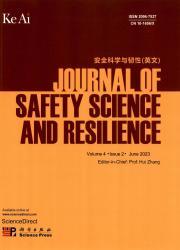基于深度学习和边缘计算的建筑物坠落行为检测方法
IF 3.4
Q1 PUBLIC, ENVIRONMENTAL & OCCUPATIONAL HEALTH
引用次数: 0
摘要
本研究提出了一个整合YOLOv11和STGCN的模型,用于准确实时地检测建筑物内的坠落行为。开发了包含六名志愿者摔倒行为的专门视频数据集,并用于验证该模型在云计算和边缘计算环境中的有效性。在云计算环境中获得的结果具有计算资源充足和没有实时约束的特点。该模型对跌倒行为的查全率、查全率和f1得分均超过0.98。在实际测试环境中,将该模型集成到边缘计算设备中,直接处理实时视频流数据。Jetson ORIN NX 16GB设备的漏检率为18%,而Jetson AGX ORIN 64GB设备的漏检率较低,为15%。同样,在Jetson ORIN NX 16GB设备上观察到的误报率为16%,在Jetson AGX ORIN 64GB设备上观察到的误报率为12%。高性能云计算集群和边缘计算设备之间以及不同边缘计算设备之间的这些性能差异可能归因于计算资源、数据质量和设备参数的差异。结果证明了该模型在资源受限环境下进行实时跌倒检测的潜力。本文章由计算机程序翻译,如有差异,请以英文原文为准。
A deep learning and edge computing integrated approach for fall behavior detection in buildings
This study proposes a model integrating YOLOv11 and STGCN for accurate and real-time detection of fall behaviors within buildings. A specialized video dataset comprising fall behaviors performed by six volunteers was developed and used to validate the model’s effectiveness in cloud computing and edge computing environments. The results obtained in the cloud computing environment were characterized by ample computational resources and the absence of real-time constraints. The model achieved precision, recall, and F1-score for fall behaviors exceeding 0.98. The model was integrated into edge computing devices in an actual test environment to directly process real-time video stream data. A missed detection rate of 18 % was observed on the Jetson ORIN NX 16GB device, while the Jetson AGX Orin 64GB recorded a lower missed detection rate of 15 %. Similarly, a false alarm rate of 16 % was observed on the Jetson ORIN NX 16GB device and 12 % on the Jetson AGX Orin 64GB device. These performance differences between the high-performance cloud computing cluster and edge computing devices, as well as among different edge computing devices, may be attributed to variations in computational resources, data quality, and device parameters. The results demonstrate the potential of the proposed model for real-time fall detection in resource-constrained environments.
求助全文
通过发布文献求助,成功后即可免费获取论文全文。
去求助
来源期刊

安全科学与韧性(英文)
Management Science and Operations Research, Safety, Risk, Reliability and Quality, Safety Research
CiteScore
8.70
自引率
0.00%
发文量
0
审稿时长
72 days
 求助内容:
求助内容: 应助结果提醒方式:
应助结果提醒方式:


